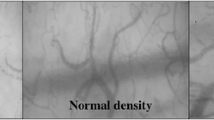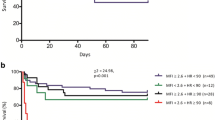Abstract
Objective
Sublingual microvascular videomicroscopy can assess tissue perfusion in critically ill patients; however, data analysis is currently limited to delayed off-line evaluation. We hypothesized that a real-time point-of-care (POC) determination of the microcirculatory flow index (MFI), an established metric for assessing microcirculatory perfusion, agrees well with the conventional off-line analysis.
Design
Prospective observational study.
Setting
Urban academic intensive care unit.
Participants
A heterogeneous population of critically ill patients.
Measurements and results
A single operator performed side stream darkfield videomicroscopy of the sublingual microcirculation and made a POC determination of MFI in real-time on a portable bedside monitor by assigning a score (0 = no flow to 3 = normal) to each quadrant of the image and averaging the four values. After image processing, de-identification and randomization, the same operator, blinded to the previous interpretation, repeated the MFI assessment by viewing an AVI-formatted image sequence on a 94 cm 1,080 pixel LCD monitor (reference standard). There were 205 paired measurements in 18 subjects. The POC and reference standard MFI had good agreement by Bland–Altman analysis [mean difference of −0.031, SD = 0.198 (95% CI, −0.43 to 0.37)]. The POC assessment was 94% sensitive and 92% specific for detecting impaired microvascular flow (defined a priori as an MFI < 2.5 based on previously published data).
Conclusions
A POC determination of MFI had good agreement with conventional off-line analysis, and was highly sensitive and specific for detecting impaired microvascular flow. This real-time technique may be useful in future clinical trials targeting impaired microcirculatory perfusion in critically ill patients.


Similar content being viewed by others
References
De Backer D, Creteur J, Dubois MJ, Sakr Y, Vincent JL (2004) Microvascular alterations in patients with acute severe heart failure and cardiogenic shock. Am Heart J 147:91–99
De Backer D, Creteur J, Preiser JC, Dubois MJ, Vincent JL (2002) Microvascular blood flow is altered in patients with sepsis. Am J Respir Crit Care Med 166:98–104
Fox-Robichaud A, Payne D, Hasan SU, Ostrovsky L, Fairhead T, Reinhardt P, Kubes P (1998) Inhaled NO as a viable antiadhesive therapy for ischemia/reperfusion injury of distal microvascular beds. J Clin Invest 101:2497–2505
Trzeciak S, Dellinger RP, Parrillo JE, Guglielmi M, Bajaj J, Abate NL, Arnold RC, Colilla S, Zanotti S, Hollenberg SM (2007) Early microcirculatory perfusion derangements in patients with severe sepsis and septic shock: relationship to hemodynamics, oxygen transport, and survival. Ann Emerg Med 49:88–98
Boerma EC, Mathura KR, van der Voort PH, Spronk PE, Ince C (2005) Quantifying bedside-derived imaging of microcirculatory abnormalities in septic patients: a prospective validation study. Crit Care 9:R601–R606
De Backer D, Hollenberg S, Boerma C, Goedhart P, Buchele G, Ospina-Tascon G, Dobbe I, Ince C (2007) How to evaluate the microcirculation: report of a round table conference. Crit Care 11:R101
Sakr Y, Dubois MJ, De Backer D, Creteur J, Vincent JL (2004) Persistent microcirculatory alterations are associated with organ failure and death in patients with septic shock. Crit Care Med 32:1825–1831
Trzeciak S, McCoy JV, Phillip Dellinger R, Arnold RC, Rizzuto M, Abate NL, Shapiro NI, Parrillo JE, Hollenberg SM (2008) Early increases in microcirculatory perfusion during protocol-directed resuscitation are associated with reduced multi-organ failure at 24 h in patients with sepsis. Intensive Care Med 34:2210–2217
Arnold RC, Parrillo JE, Trzeciak S, McCoy J, Hollenberg SM, Dellinger RP (2007) Impact of cardiopulmonary bypass on microcirculatory perfusion: a pilot study (abstract). Inflamm Res 56:S217
Groner W, Winkelman JW, Harris AG, Ince C, Bouma GJ, Messmer K, Nadeau RG (1999) Orthogonal polarization spectral imaging: a new method for study of the microcirculation. Nat Med 5:1209–1212
Harris AG, Sinitsina I, Messmer K (2000) The Cytoscan Model E-II, a new reflectance microscope for intravital microscopy: comparison with the standard fluorescence method. J Vasc Res 37:469–476
Mathura KR, Vollebregt KC, Boer K, De Graaff JC, Ubbink DT, Ince C (2001) Comparison of OPS imaging and conventional capillary microscopy to study the human microcirculation. J Appl Physiol 91:74–78
Dubin A, Edul VS, Pozo MO, Murias G, Canullan CM, Martins EF, Ferrara G, Canales HS, Laporte M, Estenssoro E, Ince C (2008) Persistent villi hypoperfusion explains intramucosal acidosis in sheep endotoxemia. Crit Care Med 36:535–542
Bland JM, Altman DG (1986) Statistical methods for assessing agreement between two methods of clinical measurement. Lancet 1:307–310
Bland JM (2008) How can I decide the sample size for a study of agreement between two methods of measurement? http://www-usersyorkacuk/~mb55/meas/sizemethhtm
Bland JM, Altman DG (1999) Measuring agreement in method comparison studies. Stat Methods Med Res 8:135–160
De Backer D, Creteur J, Dubois MJ, Sakr Y, Koch M, Verdant C, Vincent JL (2006) The effects of dobutamine on microcirculatory alterations in patients with septic shock are independent of its systemic effects. Crit Care Med 34:403–408
De Backer D, Verdant C, Chierego M, Koch M, Gullo A, Vincent JL (2006) Effects of drotrecogin alfa activated on microcirculatory alterations in patients with severe sepsis. Crit Care Med 34:1918–1924
Trzeciak S, Cinel I, Phillip Dellinger R, Shapiro NI, Arnold RC, Parrillo JE, Hollenberg SM (2008) Resuscitating the microcirculation in sepsis: the central role of nitric oxide, emerging concepts for novel therapies, and challenges for clinical trials. Acad Emerg Med 15:399–413
Vincent JL, Moreno R, Takala J, Willatts S, De Mendonca A, Bruining H, Reinhart CK, Suter PM, Thijs LG (1996) The SOFA (Sepsis-related Organ Failure Assessment) score to describe organ dysfunction/failure. Intensive Care Med 22:707–710
Acknowledgments
This study was supported in part by a Resident Research Grant from the Emergency Medicine Foundation to Dr. Arnold. Dr. Trzeciak’s effort to this project was supported by a grant from the National Institutes of Health/National Institutes of General Medical Sciences (K23GM83211).
Conflict of interest statement
None of the authors have financial conflicts of interest to disclose.
Author information
Authors and Affiliations
Corresponding author
Additional information
On behalf of the Microcirculatory Alterations in Resuscitation and Shock (MARS) Investigators.
Electronic supplementary material
Rights and permissions
About this article
Cite this article
Arnold, R.C., Parrillo, J.E., Phillip Dellinger, R. et al. Point-of-care assessment of microvascular blood flow in critically ill patients. Intensive Care Med 35, 1761–1766 (2009). https://doi.org/10.1007/s00134-009-1517-1
Received:
Accepted:
Published:
Issue Date:
DOI: https://doi.org/10.1007/s00134-009-1517-1




